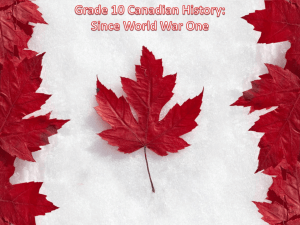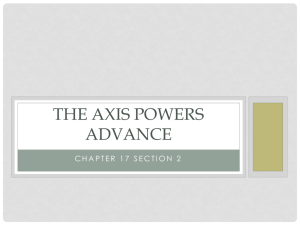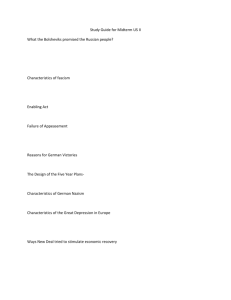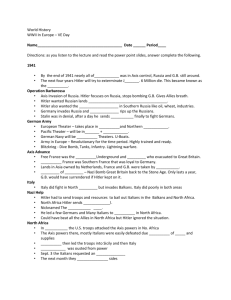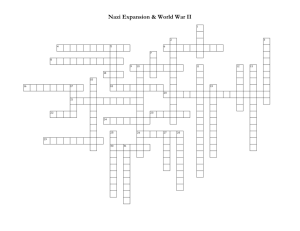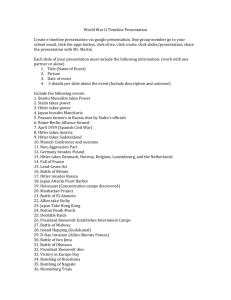World War II poland notes
advertisement
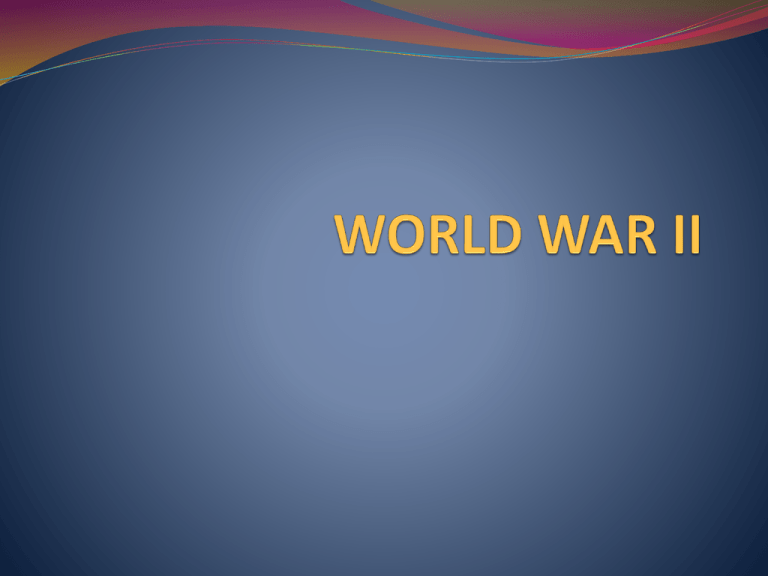
Europe after World War I PEACE -- Treaty of Versailles left many European nations dissatisfied. - France thought it was not harsh enough on Germany - -- Italy felt ignored. German Outrage Germany’s economy really suffered because of the Treaty Forced Germany to give up control of some of its land and required Germany to make heavy reparation payments to other countries. INFLATION: rising prices. By 1923- Germany currency had simply ceased to have an meaningful value. Bottom Line: Germany was going through troubled times. TOTALITARIAN LEADERS ARISE Leader who reflected and expressed the people’s bitterness and anger. These leaders promised a return to greatness for their nations. -- was appealing to their unhappy people that many were willing to give up basic freedoms in return for the hope of future glory. TOTALITARIAN- A FORM OF GOVERNMENT IN WHICH THE PERSON OR PARTY IN CHARGE HAS ABSOLUTE CONTROL OVER ALL ASPECTS OF LIFE FASCISM Stressed the glory of the state “Everything in the State, nothing outside the State, nothing against the State.” -- rights and concerns of individuals were of little importance. Forbids/puts down opposition Uses violence and war to invigorate the people Dictatorship Government by a leader or group that holds unchallenged power and authority. ONE, SINGLE PERSON This allowed no other political parties and ruthlessly crushed opponents. BENITO MUSSOLINI Italy: Fascist JOSEF STALIN USSR - COMMUNIST EMPEROR HIRHITO JAPAN: FASCIST ADOLF HITLER GERMANY: FACIST HITLER’S RISE 1889: Born in Austria 1907: Failed Art Student 1918: Decorated veteran of WWI 1919: National Socialist Party (Nazis) 1923: Wanted to imitate Mussolini’s March to Rome Marched to Munich, Arrested, Sent to Jail(for nine months) 1925: “Mein Kampf” My struggle– Written while he was in prison. Stressed nationalism and devotion to the state. 1932: Elected, quickly moves up to “Chancellor” 1933: The Nazis were the most powerful party in the nations. HITLER 1923- Hitler organized an effort to seize power in Germany by force. Failed. Was imprisoned for nine months of a five year sentence. MEIN KAMPF (MY STRUGGLE) -- dreamed of uniting all the Germans of Europe in a great empire. “Germany will either be a world power or there will be no Germany.” he wrote. Mein Kampf Hitler blamed Jews for many of Germany’s problems and believed that they threatened the purity of the Aryan race. “If we pass all the causes of the German collapse in review, the ultimate and most decisive remains the failure to recognize the racial problem and especially the Jewish menace.” -- Adolf Hitler, 1924. When he got out of prison he was determined to gain power through peaceful means. By 1933 the Nazis were the most powerful party in the nation. RHINELAND - March 1936 Treaty of Versailles said that Germany was required to keep its troops out of an area in the Rhine River valley along the French border. WHY? To protect France against possible German aggression. MARCH 1936–Hitler sent German troops into the Rhineland. -- Claiming that a recent French military agreement with the Soviet Union threatened Germany. March 1936 France was alarmed Did not take military action against Germany Britain did not want to go to war over it Germany’s troops remained – Hitler grew confident. ANSCHLUSS -- March 1938 2 years later… Hitler took action to gain control of neighboring Austria. (Austrian by birth) 1938- tried to force the Austrian government to agree to Anschluss – UNION WITH GERMANY They refused, and Hitler sent troops in. Germany unifies Austria SUDETENLAND -- September 1938 Plans to gain control of a German-speaking portion of Czechoslovakia called the SUDETENLAND Encouraged Germans in the Sudetenland to protest against Czechoslovakian rule. 2. Threatened a military attack. 1. MUNICH AGREEMENT- October 1938 Neville Chamberlain- British Prime Minister met with Hitler and French premier Edouard Daladier, Italy’s Mussolini, and Germany’s Hitler. At a meeting in Munich, Chamberlain and Daladier agreed to allow Hitler to annex the Sudetenland – AKA make it part of Germany. Czechoslovakia (had no representative) protested the agreement. Daladier signing Munich Agreement Hitler signing MARCH 1939 Hitler sent troops into what remained of Czechoslovakia TOOK ALL OF IT! APPEASEMENT APPEASEMENT- giving in to aggressive demands to maintain PEACE. - prevented the outbreak of a needless war. In your groups On page 392- please read out loud the two quotes from Neville Chamberlain and Winston Churchill. Answer the two questions in your notebook (section that has the quotes) (10 minutes) PACT WITH RUSSIA AUGUST 1939- he announced a nonaggression pact with Stalin’s Soviet Union Stalin agreed Hitler promised not to attack the Soviet Union and vice versa. “I have the world in my pocket.” Hitler after Stalin agreed to the deal. HITLER ATTACKS POLAND To provide an excuse for the attack, Hitler had a German criminal dressed in a Polish military uniform. The man was taken to the German-Polish border and shot. SEPTEMBER 1, 1939 Germany claimed it had been attacked by Poland, using the dead criminal as proof. German troops immediately launched a massive invasion of Poland. BLITZKRIEG “Lightning War.” Featured an overwhelming combination of air attack and fast- moving armored strikes to drive deep into enemy territor. -- Germans were well trained and used the blitzkrieg to devastate Poland -- By the end of the month, Poland was in German hands. ALLIES SEPTEMBER 3, 1939, Great Britain and France declared war on Germany. -- they became known as the allies. - Little they could do to slow Hitler in Poland Formed their own strategy ALLIES STRATEGY DECIDED NOT TO ATTACK HITLER AND WAIT FOR HIS NEXT MOVE HOPED GERMAN FORCES WOULD WEAKEN BY TRYING TO BREAK THROUGH FRANCE’S STRONG DEFENSE. SITZKRIEG Winter of 1939-1940 Period of inaction came to be known as the sitzkrieg, or “phony war.” What was Germany planning????? MAGINOT LINE STRING OF BUNKERS AND FORTRESSES THAT LINED PART OF THE FRENCH-GERMAN BORDER. Defense between France and Germany. April 1940 Hitler sends forces in Denmark and Norway **aimed at improving Germany’s access to the Atlantic Ocean May 1940 One group of German troops quickly conquered the Netherlands and stormed into Belgium. Then they were met by Belgian, British, and French units. Allied ships and hundreds of civilian boats plucked nearly 340,000 troops from the coast and carried them to Great Britain. France Falls German’s bypassed the Maginot Line and shattered France’s defensive plan. By the end of June, France had surrendered to Germany and Italy, which had joined the war earlier this month. German forces now occupied much of France. The rest was under the control of French officials who cooperated with Hitler. VICHY FRANCE Part of France controlled by Hitler. BATTLE OF BRITAIN Britain was now led by Winston Churchill -- had a gift for inspiring courage and confidence among the British people. He refused to try to negotiate a peace agreement with Germany. MEANWHILE…Hitler was planning to invade Great Britain. BATTLE OF BRITAIN GERMAN PLAN 1. Destroy the British Royal Air Force, or RAF. Outcome: FAIL. Using a new technology that used radio waves to detect approaching airplanes, the RAF inflicted heavy damage on German planes. BATTLE OF BRITAIN As the battle wore on… The German air force, Luftwaffe, bombed London. *Goal of this- to terrorize the public so the would lose the will to fight. -1000s died in the raids, but Churchill helped keep the nation’s spirit up. BATTLE OF BRITAIN Americans followed the Battle of Britain over thrilling radio reports of Edward R. Murrow. By late 1940, the Battle of Britain was over. The British had stopped the Luftwaffe. He was an American Reporter stationed in London. Live broadcasts described the air raids as bombs exploded around him -- Hitler was forced to call off the attempted invasion. TENSIONS IN EAST ASIA In 1940, Japan formed a military alliance with Germany and Italy. These three nations become known as the AXIS POWERS. AXIS POWERS American Isolationism- What is going on? After WWI, Americans did NOT want to go to war again. The desire to avoid involvement in foreign wars was known as ISOLATIONISM. Most Americans remained read to defend their country and its interests. Isolationists wanted to preserve America’s freedom to choose the time and place for such action. NEUTRALITY ACTS Passed in 1935- law meant to prevent the nation from being drawn into war as it had been in 1917. At first– NO WEAPONS FOR COUNTRIES WAR Then – Cash-and-Carry- Countries at war were allowed to purchase American goods as long as they paid cash and picked up their orders in American ports. *Roosevelt hoped that this policy would allow the Allies to slow Hitler’s Advances. Election of 1940 -- Roosevelt decided to run for a third term in office. (had never been done before) Voters decided to stick with him. GOAL: make the United States the “arsenal of democracy.” LEND-LEASE ACT- United States would lend England weapons for FREE! ATLANTIC CHARTER Roosevelt and British Leader Winston Churchill met secretly on a ship off the coast of Canada. There they agreed to this Atlantic Charter -- Proclaimed the shared goals of the United States and Britain in opposing Hitler and his allies. JAPAN ATTACKS PEARL HARBOR By late fall of 1941, American leaders were convinced that war between the United States and Japan was likely. American officials were determined not to fire the first shot For months, Japanese military leaders had been developing plans for a surprise attack on the American naval base at Pearl Harbor, Hawaii. DECEMBER 7, 1941 : Germany, Italy, Japan would help each other create a “new order” because of aggression America placed an embargo on Japan (is the partial or complete prohibition of commerce and trade with a particular country.) Japanese wanted to neutralize Americans Pearl Harbor is attacked FDR’s Address to America “A day that will live in infamy” 2400 Americans were dead Japan, lost only a handful of submarines and fewer than 30 aircraft. AMERICAN REACTION ANGER FEAR Rumors spread that Japanese troops would soon invade the West Coast. They strung beaches with barbed wire. DECEMBER 8th, 1941 Roosevelt asked Congress for a declaration of war. -- two days later, Italy and Germany declared war on the United States. MOBILIZING ARMED FORCES Needed soldiers and sailors to fight the Axis Powers Following Pearl Harbor, Roosevelt extended the draft. Millions volunteered Eventually, 16 million Americans would enter the armed forces. WOMEN Women filled a variety of vital roles in the military 10,000 women joined the Women Accepted for Volunteer Emergency Service, or WAVES Navy program, in which women did necessary clerical work that would otherwise have to be performed by men. 1000 women joined the WOMEN AIRFORCE SERVICE PILOTS, or WASPS WOMEN’S ARMY CORPS, or WAC 150,000 women served. By 1943, demand for their services was so great that the army created the Women’s Army Corp. ROSIE THE RIVETER Producing enough supplies to fight the war required many workers -- American men were leaving their factory jobs by the millions to join the armed forces. Number of women working outside the home rose dramatically. “I was a woman doing a ‘man’s job!” Working women of the war came to be represented by the symbolic figure known as ROSIE the RIVETER. MANHATTAN PROJECT Most significant science program of World War II. -- Top secret program to build an ATOMIC BOMB. ATOMIC BOMB- a powerful weapon that used energy release by the splitting of atoms. Research had begun in 1939, in fear that Germany was already working on such a weapon. African Americans in the workplace DEMAND FOR FACTORY WORKERS White women took many of these jobs, African Americans found new opportunities as well. BRACERO PROGRAM: The demand for farm labor led the U.S. and Mexican governments to establish this program. *Gave some Mexican workers the chance to work temporarily in the U.S. ZOOT SUIT RIOTS Arrival of thousands of Hispanic workers led to increased ethnic tensions. In California, tensions boiled over into violence. ZOOT SUIT RIOTS June 1943, white sailors stationed in Los Angeles fought with groups of Mexican American youths during a week of terrible violence. Named after the zoot suit, flashy style of clothing favored by some Mexican American young men. BATTLE OF ATLANTIC Control of the seas was key to the U.S. and Allies in defeating the Axis Powers. Bismarck was the pride of the German fleet. When Great Britain sunk it It was by the sea that the U.S. could deliver soldiers and supplies to opponents of Hitler. in 1941, Germany went back to the U- BOAT BATTLE OF THE ATLANTIC Allies had learned to protect their ships against U-Boats by forming CONVOYS. (remember….is a group of vehicles, typically motor vehicles or ships, traveling together for mutual support and protection) -- Aircraft flying over the convoy helped spot U-Boats. British and Americans did not have enough vessels to form effective convoys Made it easy for U-Boats to attack supply ships bound for Great Britain. WOLF PACK- U-Boats hunted in groups and attacked at night. HAPPY TIME Germany’s time during 1940-1941 U-boats sent 100s of ships and tons of supplies to the bottom of the sea In a few short months, 360 American ships were sunk compared to just 8 German U-boats. American shipyards began producing new ships at an amazing rate. -- formed larger, better-equipped convoys By the wars end, 70% of the Germans who had served on a submarine were dead THE ATLANTIC BELONGED TO THE ALLIES Battle of Stalingrad Summer of 1941- Hitler breaks his non-aggression pact with Stalin and the Soviet Union -- Soviet Union decided to join the Allies -- Next several months German forces stormed across the Soviet countryside. In the Spring, German armies went after the Soviet Union City of Stalingrad was attacked in 1942. Bloodiest fighting in the history of warfare, Soviets refused to let Stalingrad fall. Germans advance in Stalingrad BATTLE OF STALINGRAD GERMANS FAILED TO TAKE STALINGRAD In the fighting that followed, 250,000 Axis solders were trapped by Soviet force. Stalingrad was the beginning of Germany’s collapse in the Soviet UNION Started pushing Soviet forces began to push German forces back toward Germany. Hitler’s forces suffered losses of some 2 million, and the Soviets paid an even higher price – 12 million soldiers August, 1942: Nazis invade Stalingrad Germans surrender in 1943 OPERATION TORCH Commander of what came to be called OPERATION TORCH DWIGHT D. EISENHOWER – U.S. LIEUTENANT GENERAL • Plan called for American forces to invade the North African countries of Morocco and Algeria in November 1942 -- Fight for NORTH AFRICA Anti-Semitism Hostility toward or prejudice against Jews. KRISTALLNACHT November 8 and 9, anti-Jewish Riots broke out across Germany Became known as Kristallnacht, “Night of the Broken Glass.” Claimed that the attacks were a spontaneous reaction to the assassination of a Nazi official by a Jewish teenager. -- thousands of Jewish businesses and places of worship were damaged. FINAL SOLUTION Hitler proposed a killing of an entire people – GENOCIDE – At first, the bloody work was carried out by mobile killing units – Einsatzgruppen (Eyen-sahtz-GROOP-uhn) Nazi officials adopted a plan known as the FINAL SOLUTION the establishment of 6 new camps Extermination camps for the widespread murder of Jews. Nearly all inmates were murdered upon their arrival. -- Exposure to poison gas in specially built gas chambers FINAL SOLUTION 3 million Jews died in Nazi extermination, another 3 million died at Nazi hands. In addition to Jews, the Nazi death machine killed about 5 millions others; prisoners of war, disabled people, etc. YALTA CONFERENCE January 1945 FDR took the presidential oath of office for the fourth. What do we do with Germany when we win?? Divide the country into SECTORS US Soviets British French After inauguration he left for a conference of the Allied leaders. Was held in a resort town, in the Soviet Union. -- “Big Three.” Roosevelt, Winston Churchill, Joseph Stalin. – Met to make plans for the end of the war and the peace that was to follow. To occupy means to take control of a place by placing troops on it. Elections in Poland USSR would declare war on Japan within 3 months of German defeat CROSSING THE RHINE As the Big Three were meeting in Yalta, Allied forces to the west of Germany were preparing to cross the Rhine River. German trooped began blowing up bridges over the Rhine in order to slow the Allies. - MARCH 1945- American forces managed to capture a bridge at Remagen APRIL 12, 1945 PRESIDENT ROOSEVELT DIES HITLER DEAD!!!!! APRIL 30, 1945 VE DAY Germany surrenders May 8. VE-DAY VICTORY IN EUROPE DAY!!!!!! HIROSHIMA: AUGUST 6, 1945 ENOLA GAY- AMERICAN B-29 -- flew over the city of Hiroshima and dropped its atomic bomb. 80,000 died immediately. 35,000 were injured. 2/3 of the city’s 90,000 buildings were destroyed. AUGUST 9, 1945 United States dropped its second bomb on NAGASAKI – DEATH TOLL 40,000.
